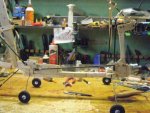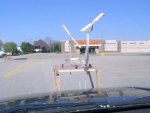John,
The model is just as you described. The coupling was done to match the rrpm of both rotors in hope that the lift would be approx. equal front and rear. I also wanted an advancing blade on each side for stability.
The rrpm in all phases of my testing never matched...usually by about 30 rpm less on the rear rotor. I assumed that it was because of airframe interferrence not allowing the same air flow to the rear rotor. I had read the NACA reports about this on real machinces and I tried all the things that was none by the NACA. I elevated the aft pylon, like on a Chinook, and the only improvement that I saw was in longitudinal stabilty. Then I tried a lower aft pylon and the same happened, lower rrpm, so I still assume that it's lower air flow through the rotor causing the difference.
In my reading, I read that tandems needed one advancing blade on each side of the airframe for stability and this is the major reason for coupling. It also allows me to shorten the airframe to reduce weight. I going to use the same 34% rotor overlap as the Chinook on this rebuild.
My next major question is, will my gearboxes be strong enough for all phases of flight? I feel that in normal cruising flight they are OK where torque is zero. In a prerotation or quick stops they may be weak...that's my question. It's the peak load as you suggested.


